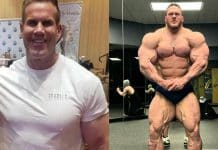No pain, no gain.
It’s the common adage when it comes to building muscle and strength. If you aren’t feeling your muscles getting pushed to the limit then you’re simply not training hard enough. So much information out there suggests that if you want to make some quality gains then it means pushing your body hard enough to cause a certain level of muscle damage in order to have your muscles repair and grow.
While no pain, no gain may be true, what’s also a reality is that if you aren’t recovering properly you could just as easily do some long term damage; damage that can ultimately harm your kidneys.
We just recently had a discussion with Milos Sarcev about some of the truths and myths about protein consumption and kidney damage – but in this article we are going to talk about a different kidney ailment.
Rhabdomyolysis, or rhabdo for short, is a pretty obscure kidney disorder that seems to be afflicting more and more active lifters these days. Symptoms include consistent pain throughout the body as well as severe swelling around the area that has been trained.
In a story written by Victoria Albert of The Daily Beast, 17 year-old lifting enthusiast Jared Shamburger and personal trainer Alex Feszko both were afflicted by this rare kidney disorder, their common link: overtraining. Where Shamburger suffered severe pain throughout his body, Feszko recalls performing a bicep and tricep routine that wasn’t all that heavy, yet experienced extremely adverse effects.
Feszko said, “Within 24 hours, I was in agonizing pain… my biceps and triceps had swollen astronomically, like tripled, quadrupled in size. It felt like my bones were going to break and my muscles were going to explode.”
So what exactly is rhabdo anyway? Orthopedist David Geier expounded on the subject.
“The breakdown products of muscle get into the bloodstream,” said Geier. “And little amounts of that would be OK. But a lot, that’s when you get organ damage—and it’s usually kidney damage.”
Dr. Geier described Shamburger and Feszko’s specific cases as exertional rhabdo, which essentially means rhabdo caused through exercise.
So why the increase in cases? It seems that the culture of fitness and bodybuilding have made these cases even more common than ever before. There’s a notion that everyone these days should look like a superhero, but that comes with severe drawbacks, especially when you don’t know when to listen to your body and drop the weight rather than push through the pain in order to get more gains.
Joe Cannon, renown exercise scientist and personal trainer explains that pushing yourself too hard too fast is a surefire way to suffer from rhabdo. With first time personal training sessions being 30 minutes in length on average, Cannon notes that many personal trainers could push their clients too fast resulting in the devastating kidney injury.
“They’re squeezing a lot of intensity in a short time period,” he said. “And that’s really the thing with rhabdo. It’s when you do a lot of stuff you’re not used to doing.”
Kidney injury is no joke, but what is really concerning is the common bodybuilding mindset of no pain, no gain. When do you know you’ve pushed your body past it’s limit? How do you know if your muscles are abnormally swollen or if you’ve just got a good pump? It truly can be a concerning problem to deal with. The best bet is to always start slowly, warm up properly and really listen to your body above all else.
For more news and updates, follow Generation Iron on Facebook, Twitter, and Instagram.
















